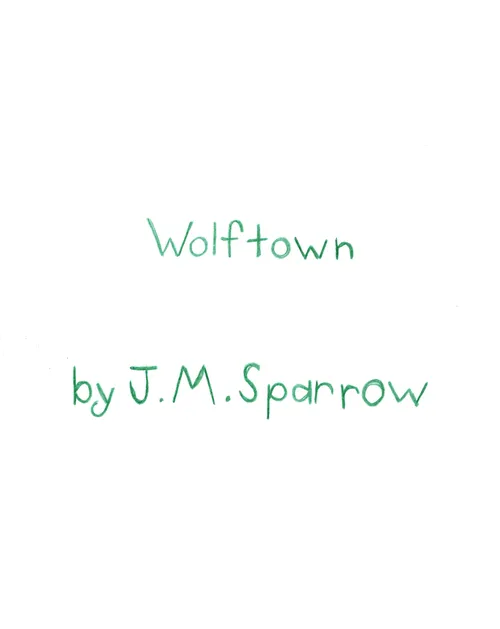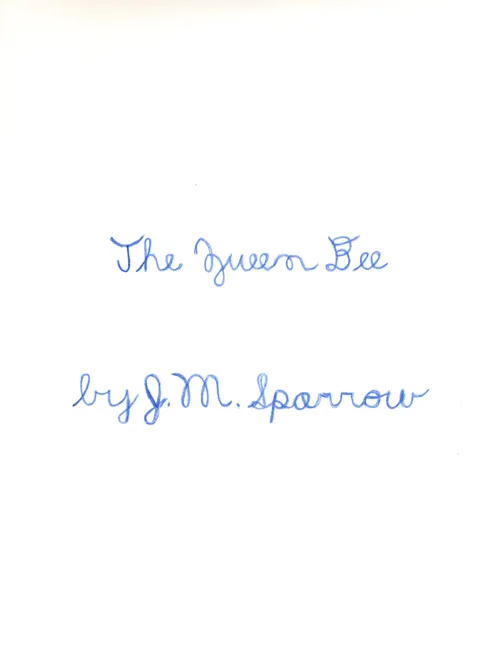As John hung up the pay phone, police officers carried a hollering man into the jail. John returned to the office area.
“The police brought in a guy yelling about the Constitution and yelling for you,” he told Kevin, a lawyer.
“Not surprising. Thanks for telling me.” Kevin stood up.
“Mr. Dalton,” Lang called.
John went to Lang’s full, tidy police desk.
“The mayor wants to see you in about five minutes,” Lang said.
“Do I have a chance of staying?”
“All the other outsiders haven’t been allowed to search, and now, with the weather, we can’t exactly send them out of town again.” Lang wrote down directions to the mayor’s office, also in City Hall, and said, “Please come back here when you finish.”
Wolftown’s police station’s doors and windows had been modernized, and it had electricity and plumbing, but most of City Hall resembled the 1800s construction. Portraits, photographs, and historical artifacts lined the walls; none included wolves.
Several people sat on benches and chairs through the Wolftown City Hall lobby. They seemed prepared to stay for hours, with things to do, like books, homework, knitting, a card game, coloring, and a happy apple toy. Volunteers set up lunch in a conference room.
John walked up the spiral staircase and down the hall, both wooden and squeaky, to the mayor’s office.
Mayor Dwyer hesitated to allow John to observe the wolf hunt. He assured Mayor Dwyer the Nature Protection Society had no intention of ridiculing Wolftown, inciting trouble, or actively discouraging tourism. If necessary, only John’s boss, Paula, would see the report and notes for months—they could release it when Wolftown’s investigation ended. He also offered to help.
Because regarding wolf matters, everybody consulted Wayne McDowell, who ran a wolf sanctuary, Mayor Dwyer argued that Wolftown did not need John's assistance. Mayor Dwyer reviewed Wayne’s humane wolf capture methods, hoping John had any other ideas, but Wayne thought of them all. Therefore, John could not assist with the wolf response.
The police investigated crimes while hunting the wolf, two potentially connected problems. John may mistake temporary stress and tension with behavior which provoked the police corruption accusations; John pointed out he had absolutely no interest in local law enforcement problems until they affected the wolf. Because he would not have authorization to view police evidence or government findings, his presence was unnecessary and a huge waste of time. Mayor Dwyer thought that John might be in the way, even if he remained in the background, or give responders yet another thing to worry about during a wolf attack.
However, Mayor Dwyer understood why John requested information about the wolf and worried about people’s reactions to the wolf. He agreed asking in person seemed more trustworthy than phoning or emailing.
The flood, wolf, murders, missing person cases, and police corruption investigation stretched Wolftown’s resources so thin that dependable civilians volunteered to help. People adapted their usual lives to the flood and sometimes the wolf; few tourists stayed in town. The police corruption investigation, missing persons, and murders were abnormal, but affected law enforcement and local government, instead of the people in general. The response was normal. Everything else about Wolftown was as usual. John thought Mayor Dwyer phrased the normalcy oddly but could not identify how or why—the ordinariness stretched over multiple sentences and popped up here and there.
John suggested understanding Wolftown’s history might help him predict people’s reactions to the wolves, so Mayor Dwyer explained.
Native Americans lived in Wolftown’s vicinity for thousands of years. European settlers arrived in 1816. Dozens of German families migrated from Wolfberg, Germany, to Wolftown in the 1800s, the first of which founded Wolftown in 1825. Nazis provoked the a major wave in the 1930s. Wolftown supported post-war Wolfberg, and in 1957, the cities twinned.
In Wolfberg, the Wolf Guard protected locals from wolves, which they continued in North America. However, North American wolves posed less of a threat than European wolves, and conservation movements began. So, the Wolf Guard hunted wolves to protect pioneers and farmers if necessary but leaned towards conserving wolves. Their presence proved to be unnecessary, but traditional. When Wayne founded Happy Howlers in 1963, many Wolf Guard members supported the organization. The Endangered Species Act of 1973 banned wolf hunting, restricting the Wolf Guard to activism. Now the handful of Wolf Guards hardly did anything other than wear the traditional costumes for the 4th of July Parade. And John suspected the remaining Wolf Guards were the patrollers, or, at least, the patrollers fulfilled the Wolf Guard’s traditional purpose.
Out-of-town reporters attempted to observe Wolftown, and Mayor Dwyer refused them. Police escorted one to the city limits. Still, Mayor Dwyer decided to consult other people and give John an answer as soon as possible; sneaking information would ruin John’s chances.
The thunderstorm had worsened through the morning. John liked thunderstorms and rainy weather, but something bothered him. He figured he was worried about the flood. As an introvert, John was annoyed by an unexpectedly extended stay in a different city than his own.
Kevin worked at a police desk. Lang gave John the internet password and permission to plug in his laptop but forbade John from using a desk with a computer or answering the phone.
John typed up everything he remembered, in any order, and then sifted through the notes. Of the Wolftown residents John spoke to, he noticed Wayne mentioned the böxenwolf first (to discredit it), Kevin described them, and Lang’s wolf hides (called “evidence”) implied the legend, if John assumed the wolf hides were wolf straps. Mayor Dwyer never mentioned them; neither did John.
A clap of thunder shook the windows and pictures of former police chiefs. Multiple lightning bolts struck simultaneously, so John unplugged his laptop.
John typed, Does Kevin think the böxenwolf myth makes people scared of wolves? Ask Kevin: How does the böxenwolf legend affect people’s perception of a wolf? But John felt uncomfortable thinking up humanities-orientated questions. He wrote them down but decided to ask questions as they occurred to him. John compared it to watching an animal in the wild, rather than in a laboratory.
Kevin wanted to tell John more about the böxenwolves at lunchtime. Volunteers fed people sheltering in churches, schools, and City Hall. When packing for Wolftown, John expected to spend quite a bit of time without refrigeration or reliable access to vegan food. He brought food in his pockets because his car despised large puddles and he walked whenever possible. John got black coffee, grapes, a sweet pickle, and vegetables.
After flipping his tie over his shoulder and spreading a napkin on his lap, Kevin said that a minority of Wolftown citizens actually believed the legend. Most people did not even think about it, let alone be influenced by it. However, during a böxenwolf situation, people would receive information from those who thought böxenwolves existed. Other people would rely on misremembered memories or make up an explanation that made sense to them. People’s behavior varied too greatly for Kevin to predict responses to a confirmed böxenwolf.
Kevin said, “The average person almost definitely thinks the wolf is a particularly ferocious wolf, but a wolf. But we can’t separate Wolftown’s emergency procedures from the böxenwolf, and people don’t like that. For example, the fences are too high for a wolf to jump and too slippery and high for the average man to scale alone.”
“The apron on the ground keeps a wolf from digging a tunnel,” John said.
“And I doubt a man would dig one. People must stay indoors until their sector is fenced in. After fencing in a sector, the patrollers search for the wolf. The fences keep people from leaving the neighborhood and the wolf from entering. People are not always willing to comply with the searches and fences.”
“Why use the walls instead of a police barricade and humane traps?”
“I suppose the wolves are too aggressive, quick, and sneaky. Nothing else stops them. And we already had the walls.”
“The people on the street come from the Wolf Guard, right? How do they affect the wolf?” John asked.
“Mayor Dwyer was very reluctant to authorize the patrollers. Higher government must know they exist because they were licensed to use tranquilizers before the wolf attacks. I would be more worried about a person attacking a patroller or policeman than a person harming the wolf.”
“But what if a patroller killed a wolf?” John asked.
“A wolf killing could be self-defense or a scared person cracking under pressure. We haven’t needed a Wolf Guard, though. Wolfberg historians say every hundred years or so, a böxenwolf becomes violent. During attacks, böxenwolves were preemptively jailed.”
“So, people came to the police station?” John said.
“Exactly. Some people sheltering in City Hall had or have a wolf strap in their possession and of their own accord, came here. They were concerned about their safety and came here for an alibi, or to aid the emergency response. The churches are traditional, and the schools are our emergency shelters. If böxenwolves are bad guys, wouldn’t keeping them, the police, and the entire local government inside City Hall be dangerous?”
John nodded; peanut butter and jelly clogged his teeth.
“In Germany, the Wolf Guard would search for the other böxenwolves, capture them, cure them, and destroy the wolf strap. We have had one violent attack attributed to a böxenwolf, in 1878. Some wolf strap owners stayed indoors or were taken in for questioning, and some helped carry out frontier justice. The mob lynched one böxenwolf, and another was killed trying to defend him. The wolf strap owners killed two people during the lynching. Everyone said wolves killed the victims, but who knows what a medical examiner would have ruled it?”
“Could it happen again?” John asked.
“The 1878 incident was chaotic and uncontrollable. Our wolf situation is chaotic in a different way, and our emergency response came from the 1878 incident. A person drawing the wrong conclusion could kill a wolf strap owner. I don’t think modern Americans would be accomplices.”
“I’m pretty sure I can say this. Mayor Dwyer said that police think somebody trained a wolf or dog to attack people. Wouldn’t that look like a böxenwolf?”
“Very possibly. A böxenwolf in human form can work a doorknob. Is it possible for a wolf to enter a building alone?”
“The news said the wolf went through a dog door. Maybe it figured out buildings have food, but that sounds like bear or raccoon behavior, not wolf behavior.
“Sometimes I make up cases and think about them, like a thought experiment. I’m speculating, but criminals have made more stupid plans. I don’t have any evidence of that happening here, and I doubt most criminals would try it. Do you suppose a person could use a wolf as a murder weapon? He’d leave böxenwolf evidence behind, like wolf straps. Maybe the police would disregard the evidence as superstitious and attribute the cause of death to a wolf attack. There are cases of people who were accused of using magic to commit a crime, where using the magic itself was not the crime. I highly doubt an American judge would allow law enforcement to prosecute a case that relies on magic.”
“Then why do people think the straps are evil?”
“For about 1,300 years, Westerners believed that quite a bit of unexplainable phenomena were magic or miracles. They believed a werewolf was not a miracle from God or a mysterious natural phenomenon. The alt—”
John jumped as thunder rolled and lightning struck. City Hall lost power, and the window blinds blocked what dim light landed on them and the windowsill. Lang called, accurately, “The generator will turn on in a minute.”
Kevin said, “Like I was saying, the alternative was magic, and they believed magic came from Satan. The böxenwolf legend began during that time period. Some religious people would use wolf straps and others wouldn’t.”
When children learned about böxenwolves in school, teachers treated it as a myth and never mentioned the Devil—that might lead to Peter Stumpp. Saying that Peter Stumpp’s criminal record gave people negative opinions about böxenwolves understated it. In the common, child-friendly legend, two friends’ hard work made them hungry. The first friend sat down to eat, while the second friend went into the trees. Soon, the first friend saw a wolf run into a field, eat an entire calf or foal, and run away. The second friend came back, complaining of a stomachache. The first friend said, “Of course, what did you expect after eating the whole thing at once?”
John said, “One very hungry, adult wolf could eat a lot of a very small, very young, newborn calf. A wolf eats almost everything, even hair and small bones.”
“Did you notice something odd about Lang’s questioning?” Kevin asked.
“I’ve never been questioned before, and I assume fiction police officers behave differently than real ones.”
“He could have told Officer Matthews to question you about the wolf straps.”
“So, they were wolf straps.”
“In fact, Lang has not questioned anybody since I came here, except for you.”
“Is that bad?”
“No, it is probably nothing important to us.” Then Kevin’s tone changed. It fell between admitting he used marijuana once in college and telling an imaginably accepting person his sexuality. “You might not believe this, but before I donated it to a museum, I wore my family’s wolf strap once.”
John bit half through the baby carrot.
“Don’t worry. It didn’t affect my legal services,” Kevin said.
“Do you mind if I ask what happened?” John chewed with effort.
“I transfigured into a wolf,” Kevin said.
John mumbled jumbled words instead, then settled for, “Really? How? What?”
“Just once,” Kevin said. “It was on September 8, 1973, in the woods when I was eighteen. My grandpa thought it was important. Our family has instructions to make wolf straps. I just tied on the wolf strap, and I looked like a wolf. My senses worked like a wolf’s, and I could think like a person. I think that protects people from us. He told me never to do anything while transfigured that I wouldn’t do while not transfigured. I didn’t have any wild animal urges or evil thoughts while wearing the wolf strap or after taking it off. I untied it with my teeth, and I transfigured into a human again. I didn’t like being a böxenwolf.”
Lang overheard the last couple of sentences. “I wanted to be a hare, but Kevin’s recipe didn’t work.”
“You used a rabbit,” Kevin said.
“I am not having this argument again!”
“The legend says the person can transfigure into a hare, but I’m not aware it ever happened. And you would probably agree that was good, or Lang would’ve been eaten.”
“I didn’t know what would happen to my mind if I was a wolf,” Lang said.
“Also, he didn’t want to kill another alleged rabbit and fail,” Kevin said.
“We ate the meat if that makes you feel better. Anyway, Mr. Dalton, you are allowed to observe if you ride along with Wayne McDowell. You will not have access to evidence, but you may make your own notes. Nobody is required to answer your questions, and everybody has the right to refuse you access to something. You must wear a reflective vest because of low visibility and to identify yourself. You must carry a tranquilizer gun, but the state of Wisconsin requires a permit. Is that acceptable?”
“Sure. John handed over his tranquilizer gun permit for verification.






This story has not been rated yet. Login to review this story.